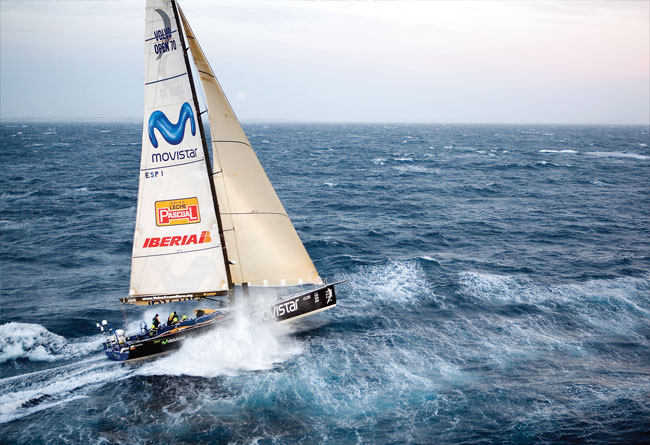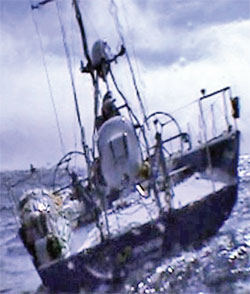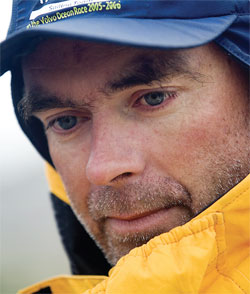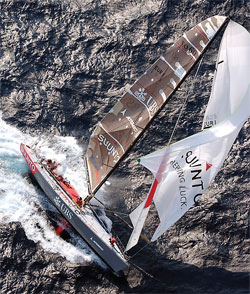

And more commitment – BOUWE BEKKING is about to start his 8th race around the globe (sic)
Seahorse Magazine: What led you to your first Whitbread race in 1985-86?
Bouwe Bekking: Back in 1984 I was a very young guy sailing on Admiral’s Cup yachts and just starting to do some transatlantics. When Conny van Rietschoten won the Whitbread onboard Flyer I saw the documentary and knew that was all I wanted to do. After a lot of calling around I got the opportunity with Dirk Nauta to race on Philips Innovator – and that was it for me.
SH: I recall that you asked for advice from the other guys on footwear before your first Southern Ocean leg…
BB: Yeh... On the dock before the start I asked the older guys what to wear and was told, ‘It’s downwind sailing, not a lot of water over the deck so leather boat shoes or simple boots.’ Great advice… I was completely underdressed and got frostbite in my toes. Tough lesson. Since then I’ve both been more careful who to ask for advice and always make sure I have warm feet.
SH: But second place in your first Whitbread was better than Peter Blake, Skip Novak and Eric Tabarly managed on their round the world debuts.
BB: We did well. Plus our average age onboard was 23. Looking back we were as green as grass. But more important was we didn’t know enough about how to optimise a rating. Had we done that better we could have perhaps won that race, but we did really well with such an inexperienced team.
SH: Is it true Philips gave you all electric shavers to take with you…
BB: Sure, we also took a big heavy camcorder and plenty of tapes onboard, plus we had a proper galley, a cook and a spare mainsail. We were not paid, but we all got a colour TV and VCR recorder at the end of the event as a thank you. By now of course I was pretty obsessed with the race, so I contacted Rolf Vrolijk who designed the boat and through him found a job. Now I was making money from my hobby… and I’ve done so ever since.
SH: In 1993-94 you joined the Whitbread 60 Winston with Brad Butterworth as skipper. On the long 7,500-mile Leg 2 from Punta del Este-Fremantle you turned back to search for Brooksfield.
BB: We first heard Brooksfield couldn’t be reached when the race organisers asked us to be ready to join a search. Brad immediately told us we were turning around along with the Maxi Merit Cup to look for the Italian boat. It was very, very windy, we had 50-60kt on the nose, very cold, snow and sleet on deck, and we broke the spinnaker pole that was sitting on the foredeck. Then we started to get delamination in the bow... Finally we got the message from Merit that they were closer to the search area and soon after that Brooksfield was found; they had had major rudder damage that left a big hole in the stern, flooding the aft compartment along with all their comms gear. We left Merit with Brooksfield and turned downwind to rejoin the race but by then we were way behind. But, as you know, when you are in the Southern Ocean the only guys you can rely on are your competitors.

Main picture: the Movistar VO70 campaign was bruising from start to finish... in this case (above) the finish being when the boat was abandoned in the North Atlantic. A proving delivery up from the boat’s builders in Australia did nothing of the sort and the chaos began on the race’s first night with rudder and keel issues that forced a stop in Portimão followed by a truck journey to Cape Town. Things only got worse. After nearly sinking at Cape Horn Bekking (below) offered his team the chance to go home; two took him up on it. He was (bottom) famously on the helm when Amer Sport spun out very publicly off Sydney making front pages all round the world


SH: Then with the Whitbread 60 Merit Cup in 1997-98... how professional was the event now getting?
BB: By now we were starting campaigns much earlier and some teams were twoboat testing. Crews were becoming more professional with top Admiral’s Cup and Sardinia Cup sailors doing the race. And of course the winner, Paul Cayard’s crew on EF, many of them came straight out of the America’s Cup. No surprise that it was also now that the sailmaking programmes really got switched on along with the big shore teams. Everything stepped up for that race. Including the budgets.
SH: You were on Merit with some fantastic sailors – Grant Dalton, Kevin Shoebridge, Ray Davies, Mike Sanderson, Dirk de Ridder, Mike Quilter. What was Grant Dalton like to sail with back then?
BB: I had never sailed with Grant Dalton before but we knew each other on the dock. The thing about Grant is he is a tremendous leader. He knows his strengths and shortcomings as a sailor and he is very honest about them. If he thinks you are a better driver or starting helmsman than he is – you do it. That was one of the things I really appreciated about Grant, he is the manager and of course a superb sailor, but it is his ability to recognise talent and then give them the freedom to do the job. He is on top of everything. And he is consumed by the drive to win.
SH: You then raced with him again on Amer Sports One in the 2000-01 Volvo Ocean Race. Were you helming during ‘the’ Chinese gybe off Sydney Heads…
BB: Yep, that was me. We had already dropped off Keith Kilpatrick off Eclipse Island in western Australia as he had a serious stomach blockage. Then Grant damaged his back so he was down below strapped into his bunk, which meant we were now shorthanded and struggling with a shy layline into the turning mark before the Heads. We were right on the edge and just lost it. It was obviously fun footage from the helicopter above, which was shown all around the world… It was less fun onboard. That was also the moment I recognised that bad news for the team can be good news for the sponsor.
But we obviously got pretty shaken up lying on our side with everything flogging away, so when we got upright I told the crew to put a spinnaker up for the short sprint to the finish. Some of the guys were hesitant as it was still pretty windy – 35kt, I think – but it worked, to get the tremors out of the team. And we nearly caught Djuice Dragons, taking it easy in front of us and just coasting in to the finish.
SH: The Volvo 70 was a bigger challenge – as you found out with Movistar in the 2005-06 race.
BB: The sailing team on Movistar were really excellent, a fantastic crew. But the boat wasn’t strong enough. We were trying something new and clearly there were many problems throughout the whole VO70 fleet. However, we also did the long delivery from Australia to Europe before the race – we learned a huge amount and broke the monohull record. But what we didn’t realise was that by the time we went racing the boat already had too many miles on the clock – it just wasn’t engineered strong enough.
The forces on those boats were way higher than the engineers imagined. This was a prototype. With any prototype you push it harder in actual competition and things break that didn’t break in testing. However on that boat things started breaking during our first night at sea.
SH: Chris Nicholson was quite the asset on Movistar south of Cape Horn.
BB: Amazing guy. The bomb doors came off around the keel head and we had tons of water firing up into the boat. We were soon up to our waists. Nico dived down into the freezing water inside the boat to connect the pumps directly to the main batteries, several times electrocuting himself. He did an incredible job, thinking very clearly under a huge amount of pressure. That was the scariest moment of the race right then. By comparison, when we eventually abandoned the boat in the Atlantic it was all very calm and organised with ABN 2 close by.
SH: You had a nice – very close – win over ABN 1 on the Melbourne-Wellington leg.
BB: We did, but on that leg we were already having major issues with the bomb doors which was an indication of what lay ahead. We could tell we were slow, with one door flapping around, but we still beat the ABN guys into Wellington… By a boatlength, I think.
SH: Then in 2008-09 on Telefónica Blue. What are your memories of the cyclone on Leg 4 Singapore to Qingdao, which in the end you won?
BB: One of the things that stuck in my mind from my earliest seamanship training is if there is severe weather, stay away from the shore. So my philosophy then was to keep plugging away and stay sailing carefully well offshore, because if something happens you don’t want to be in shallow water with steeper seas and maybe on a lee shore. Yes, we were in very harsh conditions, probably similar to when we turned back on Winston looking for Brooksfield, but I had been there before and was confident it would work. However, some of the other crews who chose – or were forced – to take shelter clearly thought we were crazy. To be honest it just got blown out of proportion by the press, as some of the other boats started breaking apart. Headlines of ‘Telefónica Blue is sailing out into a hurricane’. But I’d do the same thing again.
SH: The last event was onboard Brunel on the VO65. After the VO70s you must have been happy to at least be racing on a type of yacht you had some confidence in?
BB: These boats are very good. But when we first stepped on them we thought, wow, after the VO70 this is not fast! But I told the guys, this is what we have, if you are not happy don’t come. Come the race and the competition was close, and with budgets reduced as we all had hoped.
SH: With the boat data obtained from the last race is it now all about chemistry… the right people on the right legs?
BB: Yes, for sure that’s the biggest thing this time. But if you change around a lot you need more personnel, and that means more money so we are trying to play that equation a bit smart. We have had a huge amount of interest from possible crew, although starting this late people do have commitments with other regattas – including me. I just did the Transpac as I didn’t want to break that agreement; these arrangements are with yacht owners I have known a long time and I am not going to let them down. In fact, that is a key point I always make to some of the younger guys: if you have a commitment you have to show your commitment.
Blue Robinson
Click here for more information on the Volvo Ocean Race »
We invite you to read on and find out for yourself why Seahorse is the most highly-rated source in the world for anyone who is serious about their racing.
To read on simply SIGN up NOW
Take advantage of our very best subscription offer or order a single copy of this issue of Seahorse.
Online at:
www.seahorse.co.uk/shop and use the code TECH20
Or for iPad simply download the Seahorse App at the iTunes store


